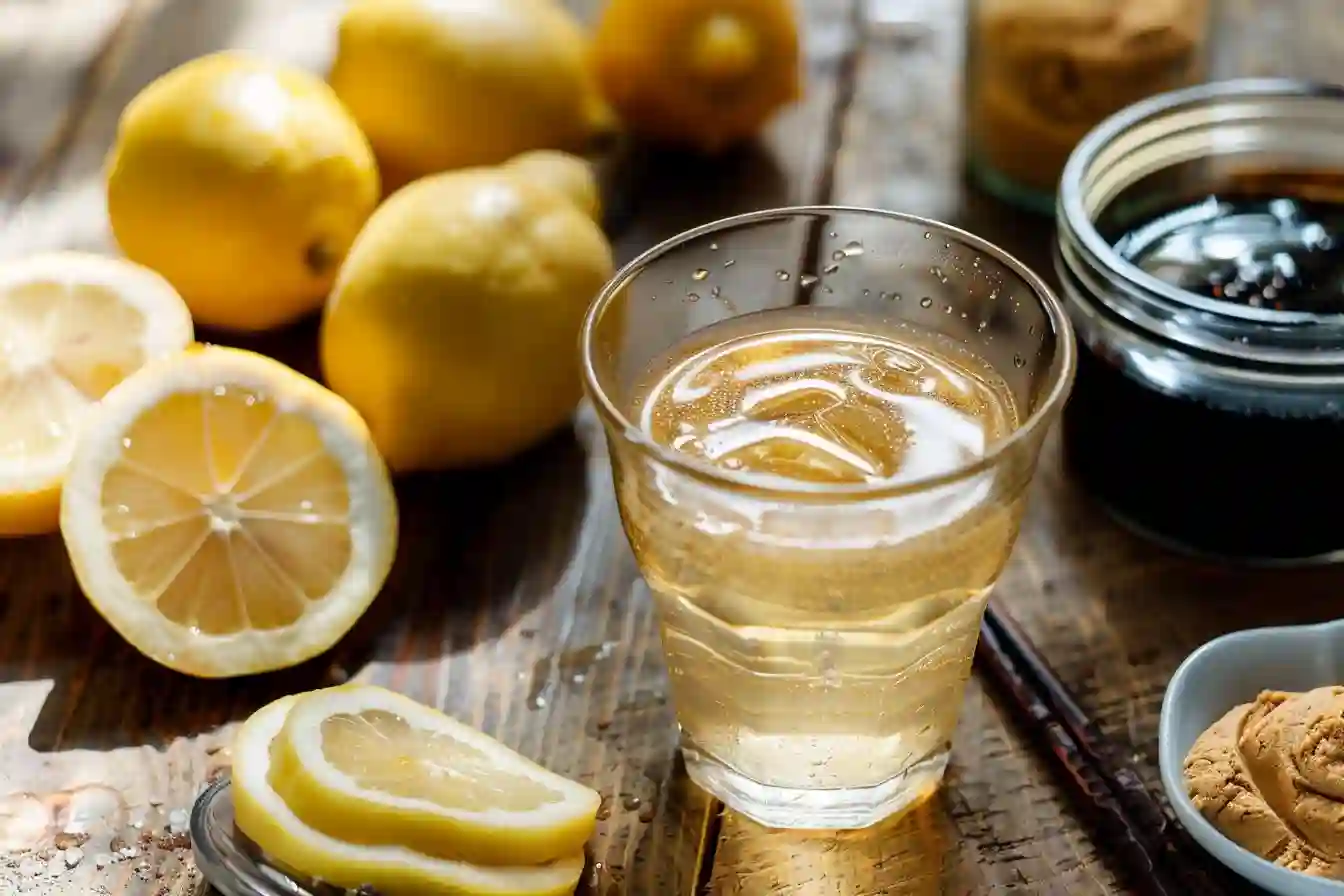I first stumbled across the Japanese Mounjaro recipe while experimenting with gut-friendly alternatives to my viral Brazilian version. It was a quiet, misty morning, and my kitchen smelled like miso and lemon — sharp, earthy, and oddly comforting. I had a jar of ume plum vinegar I’d been saving for something special, and this felt like the moment.
This drink felt different right away. It wasn’t just about curbing hunger or chasing a trend. It struck a perfect balance — miso’s warmth, daikon’s brightness, kelp’s subtle salinity — all melding into one silky, umami-rich sip. As I sipped it slowly while prepping breakfast, I felt grounded, lighter, and more focused.
That’s when I knew this wasn’t just another health hack — it was a ritual worth sharing. Whether you’re curious about Japanese wellness drinks or looking for a natural metabolism boost, this recipe has earned a permanent place in my morning rhythm. Here’s exactly how I make it.
If you’re exploring natural alternatives, you might also like this natural Mounjaro recipe — another gentle, gut-supporting drink rooted in food-based wellness.
What Exactly Is the Japanese Mounjaro Drink?
The Japanese Mounjaro recipe is a modern twist on ancient wellness traditions. It’s a savory-tart drink made with ingredients like ume plum vinegar, daikon radish, and miso — all known in Japanese culture for their digestive and anti-inflammatory benefits. While the name “Mounjaro” mimics the popular weight loss medication, this drink is completely natural, caffeine-free, and food-based.
This recipe gained traction online as a gut-friendly metabolism booster. Unlike sugary detox drinks, it leans into salty, fermented, and mineral-rich ingredients. Ume vinegar brings acidity and probiotics, while daikon offers enzyme support and gentle heat. Add a bit of miso or kelp powder, and you get a satisfying depth that makes it more than just another health tonic.
Best of all? You can customize it. Some versions go viral for adding turmeric, matcha, or pink salt. Others keep it simple with just lemon and vinegar. Either way, this drink supports mindful eating and digestion — especially when sipped slowly before meals.
Curious how it compares to the original?
Explore my Brazilian Mounjaro Recipe, the plant-based drink that started it all.

Japanese Mounjaro Drink for Weight Loss and Gut Health
- Total Time: 5 mins
- Yield: 1 drink
Description
A Japanese-inspired wellness drink featuring miso, lemon, and daikon. Supports digestion, metabolism, and mindful mornings.
Ingredients
- 1 tbsp ume plum vinegar or raw apple cider vinegar
- 1 tbsp fresh lemon juice
- 1 tsp grated daikon radish or a pinch of powdered ginger
- 1 cup water room temperature
- 1 tsp raw honey or maple syrup, optional
- ½ tsp matcha powder (optional)
- ⅛ tsp kelp powder (optional)
- ½ tsp miso paste or shio-koji (optional)
- Pinch pink Himalayan salt (optional)
- ¼ tsp turmeric powder (optional)
Instructions
- In a glass or mug, mix the ume vinegar, lemon juice, and grated daikon.
- Add the room temperature water and stir well.
- Whisk in any optional boosters until fully dissolved.
- Add sweetener if desired.
- Sip slowly before meals or in the morning.
Notes
Ume Plum Vinegar: Tangy and salty with a strong umami kick. Sub with apple cider vinegar if needed.
Grated Daikon: Traditional in Japanese tonics. Use ginger powder as a substitute if necessary.
Optional Boosters: Matcha, turmeric, kelp, and miso are popular variations — use no more than 1–2 at once.
Batch Prep: Triple the recipe and refrigerate in a sealed jar for up to 3 days.
Sweeteners: Honey and maple syrup soften the tartness if desired.
- Prep Time: 5 mins
- Cook Time: 0 mins
- Category: Drinks
- Method: Stirred
- Cuisine: Japanese-Inspired

Ingredients and Smart Substitutions
| Ingredient | Details / Substitutions |
|---|---|
| 1 tbsp ume plum vinegar | Can substitute with raw apple cider vinegar |
| 1 tbsp lemon juice | Freshly squeezed is best |
| 1 tsp grated daikon | Or use a pinch of powdered ginger as a backup |
| 1 cup room temperature water | Helps dissolve ingredients and aids digestion |
| 1 tsp raw honey or maple syrup | Optional; adds balance if you prefer a touch of sweetness |
| Optional Boosters | Add one or two of the following, not all at once: |
| ½ tsp matcha powder | For antioxidants and gentle energy |
| ⅛ tsp kelp powder | Rich in iodine and minerals |
| ½ tsp miso paste or shio-koji | Adds umami and gut-friendly probiotics |
| Pinch of pink Himalayan salt | Optional; supports hydration and mineral balance |
| ¼ tsp turmeric powder | Anti-inflammatory; adds earthy warmth |
How to Make the Japanese Mounjaro Drink
This drink is meant to be simple, soothing, and intuitive. You don’t need fancy equipment — just a mug, a spoon, and a few minutes of quiet prep. Here’s how I make it:
- Start with the base.
First, in your favorite mug or glass, mix 1 tablespoon of ume plum vinegar (or raw apple cider vinegar) with 1 tablespoon of fresh lemon juice. Then, add 1 teaspoon of freshly grated daikon or a pinch of powdered ginger. - Add water and stir.
Next, pour in 1 cup of room temperature water. Stir gently until everything looks well combined. Room temp water dissolves ingredients more evenly and is gentler on digestion. - Whisk in optional boosters.
Then, if you’re using matcha, miso, turmeric, or kelp, whisk them in until fully dissolved. However, start with just one or two at a time — these flavors are powerful and don’t need much. - Taste and adjust.
If the flavor is too bold for your liking, you can add raw honey or maple syrup. Personally, I sometimes skip it, but a small drizzle balances the tartness, especially for first-timers. - Sip slowly.
As a final step, enjoy it before meals or right after waking up. This isn’t a chug-it-down moment — let your body ease into it.
Pro Tip: To simplify your mornings, multiply the recipe and keep it in a sealed jar in the fridge for up to 3 days. Be sure to shake before each use.

Adjustments & Variations
This recipe is naturally flexible — which makes it easier to stick with and enjoy. Whether you’re adjusting for taste, ingredients on hand, or dietary needs, here’s how to make it your own.
Swap daikon for ginger
If you don’t have fresh daikon, a pinch of powdered ginger works well. Just keep in mind it has a stronger bite, so start small and taste as you go.
Use apple cider vinegar instead of ume
Ume plum vinegar has a tangy, salty kick — but raw apple cider vinegar is a great alternative. It still delivers gut-friendly benefits and pairs nicely with lemon.
Adjust your boosters
The optional ingredients — matcha, kelp powder, miso, turmeric, or pink salt — can totally change the flavor profile. It’s best to add no more than two per serving to keep things balanced.
Make it sweet or keep it savory
Some days I skip sweeteners; other times, a drizzle of raw honey softens the sharpness. Maple syrup works too — especially if you’re easing into tart or fermented drinks.
Batch prep for busy mornings
Multiply the recipe by three or four times and store it in a sealed glass jar in the fridge. Shake well before each use and enjoy within three days.
Frequently Asked Questions
The Japanese Mounjaro recipe combines 1 tbsp ume plum vinegar, 1 tbsp lemon juice, 1 tsp grated daikon (or ginger), and 1 cup of room temperature water. Optional boosters like matcha, miso, or kelp powder can be added for flavor and wellness benefits. Stir well and sip slowly before meals or in the morning. This drink supports digestion, hydration, and mindful eating.
The core version of this Japanese drink includes lemon juice, ume plum vinegar, grated daikon, and room temperature water. These ingredients are known for supporting gut health, reducing bloating, and aiding natural detoxification. It’s simple, savory, and inspired by traditional Japanese wellness tonics. You can customize it with ingredients like miso or turmeric, but the basic four are enough to get started.
Many drinkers report feeling less bloated and more satisfied between meals. While it’s not a magic cure, the Japanese Mounjaro drink combines digestion-friendly ingredients like vinegar and fermented miso, which may support metabolism when paired with mindful eating. Its popularity stems from its natural, food-based approach — not as a substitute for medication, but as a complementary wellness ritual.
The Japanese mixture for weight loss is a savory drink made with ume plum vinegar, lemon juice, daikon radish, and warm water. Often enjoyed before meals, it’s believed to aid digestion and support satiety. Variations include turmeric, kelp powder, and miso — all rooted in traditional Japanese cooking. Instead of being a fad, this mixture offers a gentle, nourishing addition to a balanced routine.
Final Thoughts and Pro Tip
There’s something grounding about starting your day with this drink. The bold tang of ume vinegar, the heat of daikon, and the quiet depth of miso all come together in a way that feels intentional. For me, it’s not just about metabolism or gut health — it’s about taking a moment to reconnect with what my body actually needs.
If you’re easing into savory wellness drinks, don’t be afraid to tweak the flavors. Add a touch of maple syrup, skip the kelp, or batch-prep a few servings in advance. What matters most is that it fits your rhythm and feels good to you. For balanced meals that support your healthy routine, explore our collection of Main Dishes for simple, satisfying recipes.
Pro Tip:
I like to sip this while prepping breakfast — it wakes up my appetite without spiking hunger. Looking for more gut-soothing options? Pair this drink with my anti-inflammatory breakfast bowl to start your day with real nourishment.
Curious how it compares to the original? Explore my Brazilian Mounjaro Recipe — the plant-based drink that started it all.
If you tried this recipe, I’d love to hear how you personalized it — drop a comment or tag me on Instagram @RecipesFlash


3 thoughts on “Japanese Mounjaro Recipe That Boosts Weight Loss Naturally”